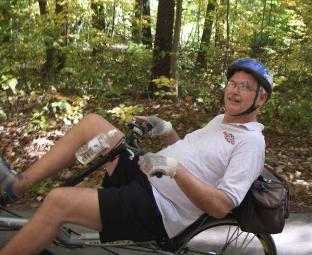Bicycles and Sore Bottoms
By Dan Sheridan
Originally Published in Marion Star July 19, 2009
A friend recently told me "I bought a bicycle and went on a bike ride, but now I have a sore bottom." Others say "I can't ride a bike; it hurts my butt too much." Perhaps many more people would ride bicycles if not for the fear of a painful posterior.
The good news is that this problem can be solved. Many cyclists do weeklong tours, and even cross-country tours, with no problems. What are their secrets?
Saddle: The bicycle saddle may be the most important ingredient in a comfortable ride. Much of a cyclist's weight is transferred to the saddle through the "sit bones" (ischial tuberosities). If the saddle is narrower than the sit bones, the saddle will be uncomfortable. If the saddle is too wide, the cyclist will rock back and forth needlessly, and this may cause chafing and discomfort.
Women's sit bones tend to be further apart than men's, so saddles that are designed for woman will typically be slightly wider and shorter than those designed for men. It's a good idea for both men and women to visit a bicycle shop and try a few different saddles.
My bicycle saddle, which is slightly padded with foam, is very comfortable for me, but what works for me may not work for someone else. Some cyclists find that tilting the saddle slightly up or down increases their comfort.
Bicycle Shorts: Bicycle shorts are much more comfortable for cycling than regular clothes. Regular clothing usually has lumpy seams where the body weight rests on the bicycle seat. By contrast, bicycle shorts have padding in this area. The slippery, stretchy fabric in bicycle shorts slides easily along the saddle, preventing the chafing that regular clothes can cause. Bike shorts are intended to be worn next to the skin.
Cyclists who are uncomfortable with the thought of wearing bike shorts sometimes wear a thin pair of athletic shorts over the bike shorts.
Stand up: Cyclists often find that periodically standing for a minute or two while riding relieves pressure on their rear. This can mean standing while coasting, standing to pedal up a hill, or stopping for an occasional break.
Ointment: Many long distance cyclists routinely apply ointments or powder to their sensitive areas before each ride. Vitamin A&D ointment is perhaps the most popular choice, but petroleum jelly, baby powder, and corn starch are also widely used. The exact product is not as important as the general idea of decreasing friction between body, saddle, and clothing.
Ride more: Paradoxically, problems with sore bottoms often go away as cyclists increase their miles. Complaints are more common early in the year, and seem to diminish as cyclists "toughen up" with repeated riding.
Cleanliness: Riders can help to prevent problems by showering soon after riding, and by always wearing a clean pair of bicycle shorts.
Lose weight: Heavier riders have more weight pushing down on the bicycle seat, and so there is more pressure on the tissue in that area. Although it's easier said than done, weight loss can add to bicycling comfort.
Recumbent bicycles: Some cyclists switch from a traditional bike to a recumbent bicycle. These bikes, such as the one pictured, resemble a chair on wheels. By spreading the pressure over a larger area, they reduce saddle discomfort. The tradeoff is that these bikes are heavier and more expensive
Return to list of articles
Bike club home page
